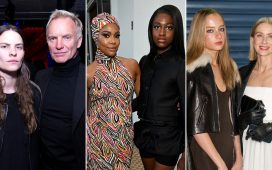“[Drag is] an art form, just like kabuki or theatre or painting. We have watercolor painters, impressionists, realists, photorealists. There’s a lot of different ways to express yourself,” Swanthula says.
“Performing in drag meant different things to us than maybe someone doing Dolly Parton at Hamburger Mary’s,” Dracmorda continues.
On the show, the Boulets enter in matching, mirrored ensembles, faces eerily white, fingernails like daggers. Imperial and menacing, they channel everything from Sleeping Beauty’s Maleficent to 1940s femme fatales as they introduce each week’s challenge. Their ménage of drag competitors have names like Frankie Doom, Disasterina, and Felony Dodger, and their tights are ripped on purpose, their beards and hairy chests are never frowned upon, and blood (fake and/or real) is never too far away.
Then there’s the floor show, which is a dramatic visual presentation of a given queen’s entire look that’s only rarely a lip sync. ”Personally, I don’t want to see a basic bitch lip sync ever in my life,” Dracmorda says. “You have to give us something, you have to perform, and just mouthing words and moving around… I hate to break it to you, but anybody can do that, and it’s just not very interesting.”
The Boulets deliberate with guest judges like Alaska Thunderfuck, Willam, Jawbreaker and GBF film director Darren Stein, and BibleGirl, then decide which performers will face “extermination” that week. Praise is lavished in unexpected ways: “It was filthy, it was disgusting, it was repulsive, it was beautiful,” Swanthula says in one episode.
The exterminations are Fear Factor-style challenges in which performers test their limits to prove they should stay in the competition: eating pig brains, getting buried alive in a coffin, having needles of increasing sizes pierced through their skin, and getting a tattoo are just a few of the extremes the Boulets have dreamed up. An eliminated queen is then “murdered” by anything from lethal injection to anthrax in a high camp-horror-glamour scene.
“Horror as a genre is essentially queer,” says Stein, who has judged Dragula but is also a fan. “There’s an essential otherness to forbidden, darkness, monsters. I think when you add a diverse queerness and glamour that’s not subtextual, that’s on the surface, that’s a little threatening to people who don’t get it — that’s what’s exciting about it.” Fans across the world agree; accordingly, Dragula will be taking performers from all seasons of the show on tour across Europe beginning August 31 and across the U.S. beginning September 30.
Along drag’s journey to the mainstream, too many audiences have forgotten there’s drag beyond Drag Race. All drag performers don’t fit into a blonde, femme, glittery box. Some would actually would like to set that box on fire, Dragula’s creators included. “We pride ourselves on celebrating the strange and the wild and the sometimes dangerous side of queer culture,” Swanthula says at the beginning of Season 2. “As the rest of the world begins to accept us, they’re also trying to squeeze us into a little box and make us conform and *tsks* that just won’t do. To us, drag is a form of radical self expression. It’s an art, and the last thing an artist needs is to be told what to do, so we’re gonna do what we want.”








